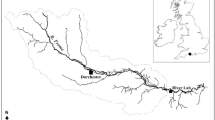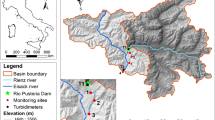Abstract
A small, coastal stream in the San Francisco Bay area of California, USA, received the discharges from a drinking-water filtration plant. Two types of discharges were present. Discharges from filter backwashing were 3–4 times base stream flow, occurred 10–60 times per day, contained fine sediments, and each lasted about 10 min. The other discharge was a large, steady flow of relatively sediment-free water from occasional overflow of the delivery aqueduct which generally lasted several hours a day.
Samples of invertebrates from natural substrates had significantly fewer taxa and lower density at the two stations below the backwash than at the two above. However, when stable artificial substrates were used, there were no significant differences among all four stations. The aqueduct apparently had no effect because the. invertebrate community at the station upstream of the backwash but downstream of the aqueduct was statistically similar to the station above the aqueduct. To test for acute toxicity, we exposed additional artificial substrates to short-term simulated backwash conditions. These exposures had no effect on invertebrate density or drift. Three-spine stickleback (Gasterosteus aculeatus) populations were also significantly reduced at the two downstream stations and were made up mostly of larger, adult fish. Prickly sculpins (Cottus asper), restricted to the most downstream station, were emaciated and had poor growth, probably as a result of scarce benthic food organisms. Artificial redds with eggs of rainbow trout (Salmo gairdneri) had significantly lower survival at two stations below the plant backwash (30.7% and 41.8%) than at the one above it (61.4%). Hatchery rainbow trout held in cages below the treatment plant from 7 to 37 days survived and continued to feed.
Thus, the major effect of the water treatment plant on fish and invertebrates probably was not from acute toxicity in the discharges or the occasionally large discharge of clean water from the aqueduct, but was from the fluctuating backwash flows containing fine sediment that displaced small fish downstream and created unstable benthic substrates for invertebrates.
The filter plant that we studied is a direct-feed type (that is, no sedimentation before filtration). These generally require greater frequencies of backwashing than do conventional plants and may therefore have greater biological impacts. Direct-feed plants are becoming increasingly popular throughout the world, for the most part because they are cheaper to build and operate. But if the associated biological problems are mitigated, then the cost savings of direct-feed compared to conventional plants may be lost.
Similar content being viewed by others
Literature cited
Beckett, D. C., and M. C. Miller. 1982. Macroinvertebrate colonization of multiplate samplers in the Ohio river: the effect of dams.Canadian Journal of Fisheries and Aquatic Sciences 39:1622–1627.
Bjornn, T. C., M. A. Brusven, M. P. Molnau, J. H. Milligan, R. A. Klamt, E. Chacho, and C. Schaye. 1977. Transport of granitic sediment in streams and its effects on insects and fish. Bulletin 17. Forest, Wildlife and Range Experiment Station, University of Idaho, Moscow, Idaho.
Brusven, M. A., C. MacPhee, and R. Biggam. 1974. Benthic insects (effects of water level fluctuation on benthic insects). Pages 67–79in K. Bayha and C. Koski (eds.), Anatomy of a river. Pacific Northwest River Basins Commission, Vancouver, Washington.
Burns, J. W. 1970. Spawning bed sedimentation studies in northern California streams.California Fish and Game 56:263–273.
Carle, F. L., and M. L. Strub. 1978. A new method for estimating population size from removal data.Biometrics 34:621–630.
Chutter, F. M. 1969. The effects of silt and sand on the invertebrate fauna of streams and rivers.Hydrobiologia 34:57–76.
Cordone, A. J., and D. W. Kelly. 1961. The influences of inorganic sediment on the aquatic life of streams.California Fish and Game 47:189–228.
Corrarino, C. A., and M. A. Brusven. 1983. The effects of reduced stream discharge on insect drift and stranding of near shore insects.Freshwater Invertebrate Biology 2:88–98.
Culp, R. L. 1977. Direct filtration.Journal American Water Works Association 69:375–378.
Dunne, T., and L. B. Leopold. 1978. Water in environmental planning. W. H. Freeman, San Francisco, 818 pp.
Elliott, J. M. 1971. Some methods for the statistical analysis of samples of benthic invertebrates. Freshwater Biological Association Scientific Publication, no. 25.
Erman, D. C. 1981. Stream macroinvertebrate baseline surveys: a comparative analysis from the oil-shale regions of Colorado, U.S.A.Environmental Management 5:531–536.
Erman, D. C., and N. A. Erman. 1984. The response of invertebrates to substrate size and heterogeneity.Hydrobiologia 108:75–82.
Erman, D. C., and D. Mahoney. 1983. Recovery after logging in streams with and without bufferstrips in northern California. Contribution no. 186, California Water Resources Center, Davis, California.
Erman, D. C., J. D. Newbold, and K. B. Roby. 1977. Evaluation of streamside bufferstrips for protection of aquatic organisms. Contribution no. 165, California Water Resources Center, Davis, California.
Fisher, S. G., and A. LaVoy. 1972. Differences in littoral fauna due to fluctuating water levels below a hydroelectric dam.Journal Fisheries Research Board of Canada 29:1472–1476.
Gammon, J. R. 1970. The effect of inorganic sediment on stream biota. Water Pollution Control Research Series, 18050 DWC 12170, Environmental Protection Agency, Water Quality Office, Washington, DC, 141 pp.
Gislason, J. C. 1985. Aquatic insect abundance in a regulated stream under fluctuating and stable diel flow patterns.North American Journal of Fisheries Management 5:39–46.
Gore, J. A. 1977. Reservoir manipulations and benthic macroinvertebrates in a prairie river.Hydrobiologia 55:113–123.
Gray, L. J., and J. V. Ward. 1982. Effects of sediment releases from a reservoir on stream macroinvertebrates.Hydrobiologia 96:177–184.
Hamilton, R., and J. W. Buell. 1976. Effects of modified hydrology on Campbell River salmonids. Environment Canada, Fisheries and Marine Services Technical Report Service PAC/T-76-20.
Hausle, D. A., and D. W. Coble. 1976. Influence of sand in redds on survival and emergence of brook trout (Salvelinus fontinalis).Transactions of the American Fisheries Society 105:57–63.
Henricson, J., and K. Muller, 1979. Stream regulation in Sweden with some examples from central Europe. Pages 183–199in J. V. Ward and J. A. Stanford (eds.), The ecology of regulated streams. Plenum, New York.
Hoffman, C. E., and R. V. Kilambi. 1970. Environmental changes produced by cold-water outlets from three Arkansas reservoirs. Water Resources Research Center Publication no. 5, University of Arkansas, Fayetteville, Arkansas.
Irving, J. R. 1985. Effects of successive flow perturbations on stream invertebrates.Canadian Journal of Fisheries and Aquatic Sciences 42:1922–1927.
Iwamoto, R. N., E. O. Salo, M. A. Madej, and R. L. McComas. 1978. Sediment and water quality: a review of the literature, including a suggested approach for water quality criteria. US Environmental Protection Agency, 910/9-78-048.
Kroger, R. L. 1973. Biological effects of fluctuating water levels in the Snake River, Grand Teton National Park, Wyoming.American Midland Naturalist 89:478–481.
Lagler, K. F., J. E. Bardach, and R. R. Miller. 1962. Ichthyology. John Wiley and Sons, New York.
Lamb, D. S., and G. C. Bailey. 1981. Acute and chronic effects of alum to midge larva (Diptera:Chironomidae).Bulletin of Environmental and Contamination Toxicology 27:59–67.
Leidy, R. A. 1984. Distribution and ecology of stream fishes in the San Francisco Bay drainage.Hilgardia 52:1–175.
Lenat, D. R., D. L. Penrose, and K. W. Eagleson. 1981. Variable effects of sediment addition on stream benthos.Hydrobiologia 79:187–194.
Leopold, L. B., M. G. Wolman, and J. P. Miller, 1964. Fluvial processes in geomorphology. W. H. Freeman, San Francisco, 522 pp.
Maciolek, J. A., and P. R. Needham. 1951. Ecological effects of winter conditions on trout and trout foods in Convict Creek, California, 1951.Transactions of the American Fisheries Society 81:202–217.
McCormick, R. F., and P. H. King. 1982. Factors that affect use of direct filtration in treating surface waters.Journal American Water Works Association 74:234–242.
Minshall, G. W., and P. V. Winger. 1968. The effect of reduction in stream flow on invertebrate drift.Ecology 49:580–582.
Moring, J. R. 1982. Decrease in stream gravel permeability after clear-cut logging: an indication of intragravel conditions for developing salmonid eggs and alevins.Hydrobiologia 88:295–298.
Mundie, J. H. 1979. The regulated stream and salmon management. Pages 307–319in J. V. Ward and J. A. Stanford (eds.), The ecology of regulated streams. Plenum, New York.
Needham, P. R., and R. Gard. 1959. Rainbow trout in Mexico and California, with notes on the cutthroat series.University of California Publications in Zoology 67:1–123.
Onodera, K., and T. Ueno. 1961. On the survival of trout fingerlings stocked in a mountain brook. II. Survival rate measured and souring effect of flood as a cause of mortality.Bulletin of the Japanese Society of Scientific Fisheries 27:530–557.
Ottaway, E. M., and A. Clarke. 1981. A preliminary investigation into the vulnerability of young trout(Salmo trutta L.) and Atlantic salmon (S. salar L.) to downstream displacement by high water velocities.Journal of Fish Biology 19:135–145.
Pearson, W. D., and D. R. Franklin. 1968. Some factors affecting drift rates ofBaetis and Simuliidae in a large river.Ecology 49:75–81.
Pearson, W. D., R. H. Kramer, and D. R. Franklin. 1968. Macroinvertebrates in the Green River below Flaming Gorge Dam, 1964–65 and 1967.Proceedings of the Utah Academy of Science, Arts and Letters 45:148–167.
Peterson, G. D., and R. A. Barnhart. 1982. Artificial seeding of fertilized eggs in salmonid streams: past, present, future. Part one: historical perspective.Flyfisher Winter:14–17.
Petts, G. E. 1980. Implications of the fluvial processchannel morphology interaction below British reservoirs for stream habitats.Science of the Total Environment 16:149–163.
Pfitzer, D. W. 1954. Investigations of waters below storage reservoirs in Tennessee.North American Wildlife and Natural Resources Conference, Transactions 19:271–280.
Phillips, R. W., R. L. Lantz, E. W. Claire, and J. R. Moring. 1975. Some effects of gravel mixtures on emergence of coho salmon and steelhead trout fry.Transactions of the American Fisheries Society 104:461–466.
Powell, G. C. 1958. Evaluation of the effects of a power dam water release pattern upon the downstream fishery.Colorado Cooperative Fisheries Research Unit Quarterly Report 4:31–37.
Radford, D. S., and R. Hartland-Rowe. 1971. A preliminary investigation of bottom fauna and invertebrate drift in an unregulated and a regulated stream in Alberta.Journal of Applied Ecology 8:833–903.
Ringler, N. H., and J. D. Hall. 1975. Effects of logging on water temperature and dissolved, oxygen in spawning beds.Transactions of the American Fisheries Society 104:111–121.
Roby, K. B., J. D. Newbold, and D. C. Erman. 1978. Effectiveness of an artificial substrate for sampling macroinvertebrates in small streams.Freshwater Biology 8:1–8.
Scullion, J., and A. Sinton. 1983. Effects of artificial freshets on substratum composition, benthic invertebrate fauna and invertebrate drift in two impounded rivers in mid-Wales.Hydrobiologia 107:261–269.
Seber, G. A. F., and E. D. LeCren. 1967. Estimating population parameters from catches large relative to the population.Journal of Animal Ecology 36:631–643.
Sorenson, D. L., M. M. McCarthy, E. J. Middlebrooks, and D. B. Porcella. 1977. Suspended and dissolved solids effects on freshwater biota: a review. Ecological Research Series, US Environmental Protection Agency, 600/13-77-042.
Stanford, J. A., and J. V. Ward. 1979. Stream regulation in North America. Pages 215–236in J. V. Ward and J. A. Stanford (eds.), The ecology of regulated streams. Plenum, New York.
Vanoni, V. A. 1964. Measurements of critical shear stress for entraining fine sediments in a boundary layer. California Institute of Technology, Series Memoranda W. M. Keck Laboratory of Hydraulics and Water Resources Report K.H-R-7, 47 pp.
Wagner, E. G. 1983. Simplifying design of water treatment plants for developing countries.Journal American Water Works Association 75:220–223.
Wagner, E. G., and H. E. Hudson, Jr. 1982. Low-dosage high-rate direct filtration.Journal American Water Works Association 74:256–261.
Williams, D. D., and J. H. Mundie. 1978. Substrate size selection by stream invertebrates and the influence of sand.Limnology and Oceanography 23:1030–1033.
Author information
Authors and Affiliations
Rights and permissions
About this article
Cite this article
Erman, D.C., Ligon, F.K. Effects of discharge fluctuation and the addition of fine sediment on stream fish and macroinvertebrates below a water-filtration facility. Environmental Management 12, 85–97 (1988). https://doi.org/10.1007/BF01867380
Issue Date:
DOI: https://doi.org/10.1007/BF01867380




